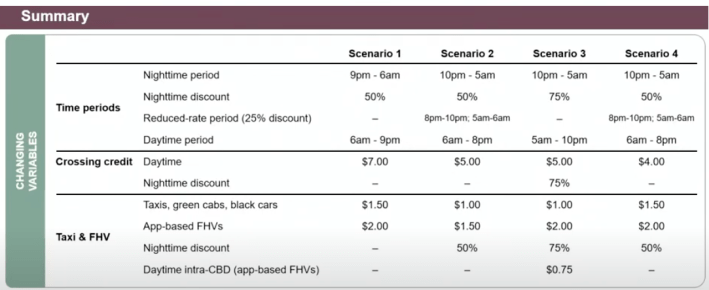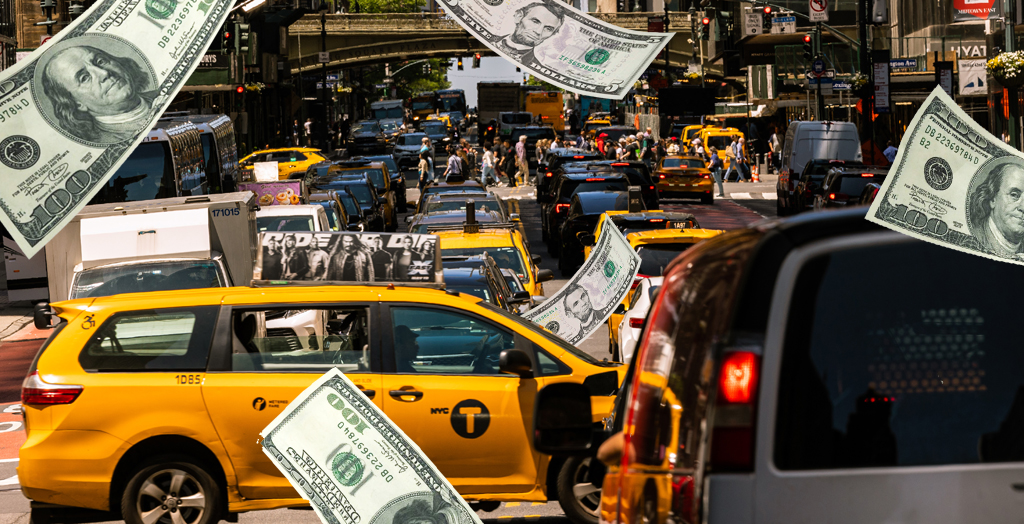Taxi passengers are going to get a break from congestion tolling — but is it too generous a break?
Earlier this month, the Traffic Mobility Review Board announced that it was recommending a per-ride fee for people who take yellow or green taxis or Ubers or Lyfts into or around Lower Manhattan. The per-ride fee eliminated an earlier proposal that cabbies would bear the full congestion toll cost (which may end up as high as $23) once per day, hurting struggling workers.
But the scenarios for the per-ride fee struck some industry experts as way too low. Under the four possibilities, the maximum congestion pricing surcharge will be $1.50 for taxi riders and $2.75 for Uber and Lyft riders entering or traveling within the zone. (Those fees would be added to the existing $2.50 surcharge for taxi trips and $2.75 surcharge for Uber/Lyft trips south of 96th Street.)

"The price point is meager," said Bruce Schaller, a taxi industry expert and former DOT official, who does support the per-ride fee concept.
Schaller believes a taxi or Uber ride that crosses into the congestion pricing zone should be priced at about 40 percent of the eventual toll. Without that kind of ratio, he argues, the MTA risks incentivizing people into cabs and Lyfts instead of onto public transit.
"Everyone should pay a noticeable amount," he said. "If you have a low fee for the taxis and the for-hires [Uber/Lyft], people just switch modes."
For yellow cab and Uber customers, the range of potential surcharges is barely noticeable. For instance, right now it costs about $21 to take a yellow cab from Tribeca to the Plaza Hotel, which means a New Yorker or a visitor making that swank choice might only pay an extra $1 on top of that fare. If you take an Uber from hip Terminal 5 to 420 Kent Ave. in Williamsburg, the lower end of the surcharge proposal means your $45 fare would rise to just $46.50.
A cab ride in Lower Manhattan, the most transit-rich area of the United States, is one of the ultimate luxury purchases, which is why Schaller wasn't the only person criticizing the amount passengers would pay under the TMRB's proposal. Assembly Member Robert Carroll (D-Park Slope), who previously pitched charging Uber and Lyft customers half the peak congestion pricing toll and exempting yellow cabs entirely, tweeted that the proposed charges were "a joke" that wouldn't do enough to limit cab traffic in Lower Manhattan.
TMRB’s recommendation to charge passengers of @Uber/@lyft an additional $1/$2 to be ferried around the congestion zone is a joke. There were 60Million FHV/Taxi trips in the zone in 22. We can’t stop congestion if we don’t limit FHV trips. Taxis shld be exempt & FHVs shld pay more https://t.co/IQzVgFB5em
— Assemblymember Robert Carroll (@Bobby4Brooklyn) October 3, 2023
Further muddying the waters? The six-member review board didn't reveal the actual price of the congestion toll, a number that will be revealed at some future date, making analysts work backwards to assess the impact on traffic.
At least one longtime congestion pricing supporter doesn't think the passenger fee needs to be 40 percent of the peak toll. Charles Komanoff, a traffic economist who has advocated for congestion pricing for decades, suggested that the MTA could get the money it needs by charging $2.25 for Uber and Lyft trips that go into or out of Lower Manhattan, while regular drivers would pay a $15 peak toll, a $9 off-peak toll and a $3 overnight toll. Komanoff's plan would raise $200 million from the surcharge and shift Uber and Lyft customers to taxis in the Central Business District.

That plan also makes a more explicit argument for exempting yellow cabs from the surcharge. Komanoff is not alone in this line of thinking. Fellow congestion pricing advocate (and former city Commissioner of Traffic) Sam Schwartz has argued for exempting yellow cabs from any new surcharge, since yellow cab drivers have to pay back loans on extremely expensive cab medallions that the city sold at high prices before the arrival of app-based "ride-share" tanked the value of the medallions. In his proposal, Komanoff said exempting yellow cabs is also a matter of rebalancing a market Uber and Lyft threw out of wack.
"Uber built its business upon, and profited from, usurping the exclusive right to pick up street hails in the taxi zone conferred on yellow cabs in the 1930s in exchange for purchasing taxi medallions," he wrote in his proposal. "Breaking the taxi monopoly has led to significantly worsened congestion while wreaking economic ruin on many taxi owners and workers."
Komanoff showed his work, but the TMRB has not.
In its Final Environmental Assessment, the MTA found that it could raise more than the legally mandated $1 billion and exempt taxi and Uber/Lyft drivers from the congestion toll if it charged passenger car drivers a peak toll of $19, an off-peak toll of $14 and an overnight toll of $10. But the lack of a toll on cab drivers would increase the number of taxis and app-hailed cabs in Lower Manhattan compared to if cabbies had to pay the toll — but the higher overall toll price still more than made up for the money lost by exempting the larger amount of these vehicles that would be in lower Manhattan.
However, the TMRB has been focused on keeping the congestion toll as low as possible, and cuts the toll by 50 percent or 75 percent outside of peak hours. No member of the board asked about the revenue or traffic implications of the policy, but based on one of the TMRB's priorities getting listed as "keep the toll low as possible," it's hard to see a $19 toll as the final recommendation.
A spokesperson for the MTA did not respond to a request for comment.






